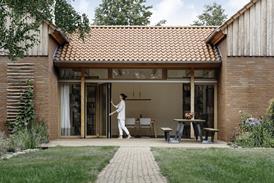A new City Academy is about to open in Middlesbrough. How do these high profile government initiatives differ from traditional schools?
As the school year begins, pupils in Middlesbrough will begin studying at a new facility that aims to meet 21st century teaching needs. Middlesbrough Unity City Academy has been designed and built under the Department for Education and Skills’ (DfES) Academies initiative, which is revamping the concept of schools and creating a potential new market for m&e contractors. Firms who may have avoided the education sector in the past due to low m&e value and profit margins should look again as services are becoming an integral part of teaching.
The Academies programme was introduced in 2000 and forms a major part of the Government’s plans to raise the standard of inner-city education. Aimed at 11-16 year olds, they are also intended to provide facilities for the surrounding community. The DfES missive stated that each one must be ‘innovative in design and built to high environmental standards’; each will also focus on a certain area of expertise.
At Middlesbrough the focus is on information and communications technology (ICT), and this is very evident on walking around the building. Over 2000 data points have been provided and there are countless computers throughout classrooms and the more relaxed ‘breakout’ teaching areas – they are not confined to one or two rooms as in older schools. Every classroom has a laptop point for the teachers’ use and electronic whiteboards replace traditional blackboard and chalk. In the circulation areas plasma screens rather than pinboards will provide information and electronic card cash top-up machines are provided in an attempt to stop bullying.
All of this electrical and electronic equipment means the amount of m&e services needed is a significant proportion of the construction value. At Middlesbrough the m&e services project value was £4 million; almost 30% of the total construction costs and 20% of the total design and build contract value.
But installing such quantities is not always simple and with high tech equipment comes high-tech architectural and construction styles, which posed some interesting challenges to Haden Young the m&e contractor on the project.
The Academy has been purpose-built to accommodate 1200 pupils. It is sited in the east of the city on former playing grounds and replaces two schools that lie either side of the new building. These are set to be demolished and housing built as part of the overall development plan.
The green, copper-clad facade gives it a distinctly futuristic feel, and on entering, a giant, bright yellow oval structure on legs dominates the atrium. Looking like it would fit nicely into a science fiction film, this is a 128-seat, acoustically sealed lecture pod.
The Academy’s oval shape masks its volume. Externally it appears compact, but it comprises 50 classrooms, dining rooms, and a large auditorium/ gym that has been built to Sport England’s standards to satisfy the need for local facilities and provide rental income for the school. The building peaks at five floors; the roof then drops down at a 15° angle to a full-height atrium.
“There’s a big ethos about being flexible for future use,” explains Haden Young’s electrical project engineer Johnpaul Bolton. “It’s certainly a school for the future and based on a concept design. It’s not a normal school.”
School services
Haden Young won the contract for the m&e installation by competitive tender. It was involved early in the construction process and developed m&e consultant Faber Maunsell’s concept services designs into working installations.
Partnerships were not contractual on the project, but Haden Young project manager Neil Crudace reports: “That was the philosphy.” This was aided by the fact that the construction team was almost identical to one that just completed another local school project together.
The mechanical plantroom is split over three floors in the north of the building. Boiler plant here feeds an underfloor heating and cooling system in the atrium and the breakout areas that run along the front of the upper floors. This is operated by manual changeover via a heat exchanger. In summer months the chiller feeds into the heat echanger to cool the school; in winter it is operated as a conventional underfloor heating system.
The floors are split into north and south for servicing. Internal classrooms have active chilled beams served by air handling units, while most external rooms are naturally ventilated. “The internal classrooms are in cooling mode most of the time, with the amount of pcs and students they have,” explains Crudace. “From the ahus they can heat it with warm air as well.” Extract is by high level atrium grilles via a fourth floor plantroom.
“Initially the biggest challenge was the co-ordination,” explains Crudace. “Although the voids were big, there’s some deep steelwork and there were quite a few pinch points getting the ductwork underneath.” Some of the large steelwork was delivered to site prefabricated with holes for services and the ductwork in the gym was changed from spiral to rectangular to suit the heights available.
Most of the ductwork is exposed at high level and follows the slope of the roof. This was positioned to avoid chilled beams and the pipework and cabling runs co-ordinated by Haden Young.
As the sports hall will also be used as an auditorium, two sets of lighting were installed – sports and auditorium house lights. The ventilation system is also manually adjustable to suit the two uses. When the hall is being used for sports it will be set at low speed, blowing in cold air; when its being used as an auditorium, the system is switched, which shuts off the ventilation for the adjacent gym and increases the speed and volume of air being blown in. The depth available for the roof-level services was restricted by the height of hall needed to meet County standards, which meant close co-ordination and the use of rectagular ducts.
Primary distribution is by two main risers: one each at the north and south ends of the building. From the lv switchroom, power is supplied to the floors by a vertical rising mains busbar. Each busbar feeds a floor sectionboard which supplies the 80 distribution boards around the school. In the classrooms, waist-height extruded aluminium trunking from Mita provides the data and telecomms containment and distribution for the high number of power and data outlets around the rooms. This two-compartment trunking was chosen as there is no need to screen between power and data cables and for its robustness.
Distribution across the floors had more unusual issues to be tackled due to the Omnicore floor construction. Bolton explains: “It’s a concrete base with rebar and polystyrene, every other section of the floor was polystyrene.” In basic terms, it resembles a giant eggbox, where the sections pointing upwards are polystyrene-filled and the sunken sections are concrete with a rebar core. “That saved on the amount of concrete that was used, but caused us a problem as were not able to fix where the polystyrene was,” adds Bolton.
“Any holes through the floor had to hit the polystyrene,” says Crudace. “If you hit the rebar it would have weakened it too much and the floor would have lost its integrity.” Another problem was running underfloor trunking. The school needed power to island desks and did not want to obstruct the floor plans by using power poles. The solution was to use bespoke, circular floorboxes from Mita designed to fit into the available spacing in the floors.
Installation in the breakout areas was simpler, but tight programming was necessary due to the number of elements involved. Trunking, floorboxes, insulation and underfloor heating pipework all had to be installed before the concrete screed could be poured.
Scaling new heights
“The modern architecture created us some problems,” explains Bolton. Much of the services in the atrium and around the pod are fixed at levels that exceeded the heights that could be reached from a traditional mobile platform. To counter this, the atrium was filled with fixed scaffolding for a period. “Basically the whole area was scaffolded out,” explains Bolton. Close co-ordination was then necessary to ensure all teams could complete their work within the set timescale. “The ductwork installers and insulator worked very closely together,” adds Bolton. “As they were putting the ductwork in they were lagging then the painter was following straight on.”
The firm has a policy of not using ladders, and with relatively high ceiling heights in classrooms and the upper floors, it developed a set of stepladders with Brett’s Ladders. These will now be used on other Haden Young projects, where working at height is necessary.
To minimise future maintenance problems, the firm suggested and installed an air sampling system in the atrium. This removed the need for smoke or heat detectors in the high level areas.
Some pupils have already had a taste of the new facilities, with a staggered move in following practical completion on 21 June. The remainder can’t fail to be impressed by the style of their school and the services they now have to hand.
Project Profile
Players
Project: Unity City Academy, Middlesbrough
Client: Unity City Academy
Project manager: Gleeds
Architect: Hickton Madeley Architects
M&E consulting engineer: Faber Maunsell
Lighting designer: Faber Maunsell
Main contractor: MJ Gleeson
M&E contractor: Haden Young
Providers
Mechanical suppliers
AHUs: Barkell
Boilers: Hoval
Chilled beams: Krantz
Chillers: Airedale International Air Conditioning
Control valves: Sauter Control Valves
Computer room a/c: Airedale
Ductwork: Galloway Group
Extract fans: Elta Fans
Fan coil units: Biddle Air Systems
Floor grilles: Waterloo
Flues: Rite Vent
Heat exchangers: Atlantic 2000
Humidifiers: Munters
Insulation system: Newcastle Insulation
Perimeter heating: BG Perimeter Systems
Pumps & pressurisation: Grundfos
Radiators: Myson, Stelrad
Sound attenuation: Alloway Acoustics
VAV boxes: Trox
Water heaters: Lochinvar
Water tank: Brimar Plastics
Electrical suppliers
BMS: Clover Controls
CCTV: Barrier Surveillance
Cable management: Mita, Cablofil, Salamander
Controls: Clover Controls
Electrical distribution: Schneider Electric
Electrical accessories: MEM 250V
Emergency luminaires: Thorn, Hagermeyer
Fire alarm/detection: Dante Fire
Floor boxes: MK, Mita
Lighting: Thorn, Hagermeyer, Aquaproof, Chalice
LV switchgear: Armah Switchgear,
Schneider Electric
Power busbar: Schneider Electric
Public address: FWA Systems
Security equipment: Barrier Surveillance
Trace heating: Northorn
Prices
Total cost: £14 million
Mechanical services cost: £2 million
Electrical services cost: £2 million
Source
Electrical and Mechanical Contractor

















No comments yet